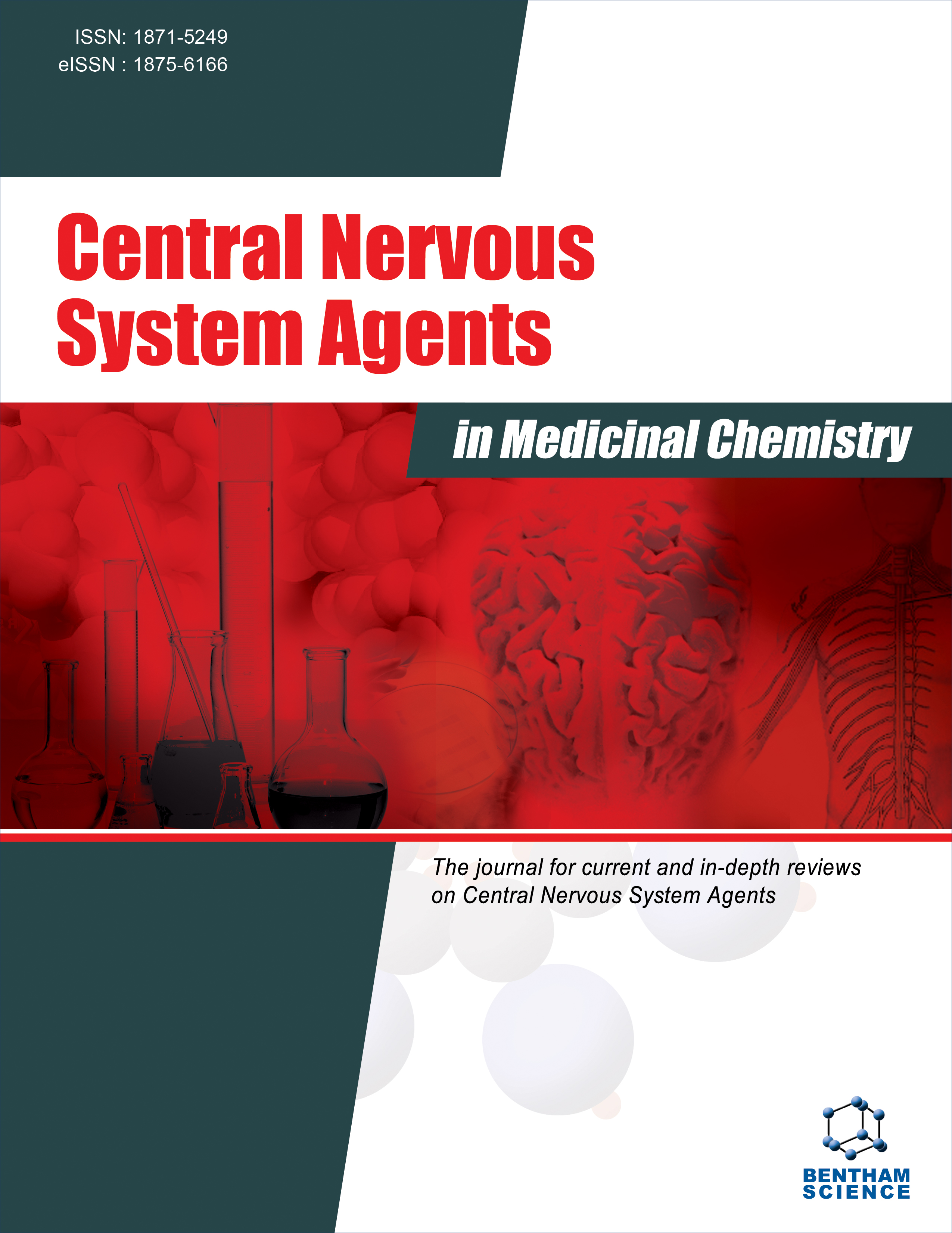- Home
- A-Z Publications
- Central Nervous System Agents in Medicinal Chemistry (Formerly Current Medicinal Chemistry - Central Nervous System Agents)
- Previous Issues
- Volume 9, Issue 3, 2009
Central Nervous System Agents in Medicinal Chemistry (Formerly Current Medicinal Chemistry - Central Nervous System Agents) - Volume 9, Issue 3, 2009
Volume 9, Issue 3, 2009
-
-
Editorial [Hot topic: Sigma1 and Sigma 2 Receptors (Guest Editor: Richard A. Glennon)]
More LessIt was more than 15 years ago that we first reviewed the “sigma enigma” [1]. At that time sigma (??) receptors represented a novel binding protein for which agents from an assortment of therapeutic classes and drugs of abuse displayed affinity. Indeed, the receptors seemed quite promiscuous because they displayed (at least micromolar) affinity for a very large number of agents encompassing a wide variety of structure-types: Read More
-
-
-
In Vitro and Ex Vivo Characterization of Sigma-1 and Sigma-2 Receptors: Agonists and Antagonists in Biological Assays
More LessMethods for addressing sigma receptor affinity and activity have been explored and although several protocols have been employed, only few procedures resulted reliable. Sigma-1 receptor affinity protocol using guinea-pig brain and (+)-[3H]-pentazocine and sigma-2 receptor affinity protocol employing rat liver and [3H]-DTG are usually reported by authors as standard procedures. By contrast, the intrinsic activity eval Read More
-
-
-
Selective Sigma-1 (sig1) Receptor Antagonists: Emerging Target for the Treatment of Neuropathic Pain
More LessA large number of therapeutic roles have been proposed for sig1 receptors but the involvement of sig1 receptor in non-acute pain had not been well explored up to now. sig1 receptor knock-out mice became available offering us the possibility to study the role of sig1 receptor in nociception, particularly in models where central sensitization processes play a significant role. Given the attractive therapeutic potential, we have de Read More
-
-
-
Sigma-1 Receptor Chaperones and Diseases
More LessAuthors: Shang-Yi Tsai, Teruo Hayashi, Tomohisa Mori and Tsung-Ping SuChaperones are proteins that assist the correct folding of other protein clients either when the clients are being synthesized or at their functional localities. Chaperones are responsible for certain diseases. The sigma-1 receptor is recently identified as a receptor chaperone whose activity can be activated/deactivated by specific ligands. Under physiological conditions, the sigma-1 receptor chaperones the functional IP3 recepto Read More
-
-
-
Imaging of Sigma1 Receptors in the Human Brain Using PET and [11C]SA4503
More LessAuthors: Jun Toyohara, Muneyuki Sakata and Kiichi IshiwataSigma1 receptors were imaged in living human brain by positron emission tomography (PET) using [11C] SA4503. A dynamic 90-min scan and kinetic analysis enabled quantification of receptor density in the brain. The sigma1 receptors were distributed throughout the brain in normal subjects, but decreased in the frontal, temporal, and occipital lobes, cerebellum and thalamus in patients with early Alzheimer's disease Read More
-
-
-
Sigma-1 Receptors and Selective Serotonin Reuptake Inhibitors: Clinical Implications of their Relationship
More LessEndoplasmic protein sigma-1 receptors represent unique binding sites in the brain, and they exert a potent influence on a number of neurotransmitter systems. Several lines of evidence suggest that sigma-1 receptors play roles in the pathophysiology of psychiatric diseases, as well as in the active mechanisms of some selective serotonin reuptake inhibitors (SSRIs). Interestingly, we reported that some SSRIs pos Read More
-
-
-
1-Cyclohexylpiperazine and 3,3-Dimethylpiperidine Derivatives as Sigma-1 (sig1) and Sigma-2 (sig2) Receptor Ligands: A Review
More LessAuthors: Francesco Berardi, Carmen Abate, Savina Ferorelli, Nicola A. Colabufo and Roberto PerroneHerein the evolution in the development of new sigma (??) receptor ligands since the middle &90s by our research group is reported. In the effort to contribute to the identification of the structural features for high-affinity ligands selective versus serotonin, dopamine and other CNS-related receptors, two general classes of (naphthalene)alkylamine compounds were prepared and explored, with the aim of addressing the affin Read More
-
-
-
Structure-Affinity-Relationship Study of Bicyclic sig Receptor Ligands
More LessAuthors: Ralph Holl, Christian Geiger, Masakazu Nambo, Kenichiro Itami, Dirk Schepmann and Bernhard WunschIt was postulated that N6-allyl bicyclic derivatives 1 bind with N-8 at the proton donor site of the sig1 receptor and that a substituent in 2-position of the bicyclic framework 1 results in unfavorable steric interactions with the sig1 receptor protein. In order to support this hypothesis both enantiomers of 6-allyl-8-(4-methoxybenzyl)-6,8-diazabicyclo[ 3.2.2]non-2-ene (2/ent-2) and 6-benzyl-8-(4-methoxybenzyl)-6,8-diazabicyc Read More
-
-
-
Development of Molecular Probes for Imaging Sigma-2 Receptors in Vitro and in Vivo
More LessAuthors: Robert H. Mach and Kenneth Theodore WheelerThe sigma-2 (sig2) receptor is proving to be an important protein in the field of cancer biology. The observations that sig2 receptors have a 10-fold higher density in proliferating tumor cells than in quiescent tumor cells, and that sig2 receptor agonists are capable of killing tumor cells via apoptotic and non-apoptotic mechanisms, indicate that this receptor is an important molecular target for the development of radiotrace Read More
-
-
-
A Structure-Affinity and Comparative Molecular Field Analysis of Sigma-2 (sig2) Receptor Ligands
More LessAuthors: Carmen Abate, Philip D. Mosier, Francesco Berardi and Richard A. GlennonSeveral sig1 receptor ligands with sub-nanomolar affinity and excellent selectivity have been reported, but relatively few sig2-selective ligands are known. 1-Cyclohexyl-4-[3-(5-methoxy-1,2,3,4-tetrahydronaphthalen-1-yl)propyl] piperazine (PB28; 1) has been reported by us as a high-affinity sig2 receptor ligand with significant sig2 selectivity, and several analogs of (1) now have been developed. Among these are the class of cyclo Read More
-
Volumes & issues
-
Volume 25 (2025)
-
Volume 24 (2024)
-
Volume 23 (2023)
-
Volume 22 (2022)
-
Volume 21 (2021)
-
Volume 20 (2020)
-
Volume 19 (2019)
-
Volume 18 (2018)
-
Volume 17 (2017)
-
Volume 16 (2016)
-
Volume 15 (2015)
-
Volume 14 (2014)
-
Volume 13 (2013)
-
Volume 12 (2012)
-
Volume 11 (2011)
-
Volume 10 (2010)
-
Volume 9 (2009)
-
Volume 8 (2008)
-
Volume 7 (2007)
-
Volume 6 (2006)
Most Read This Month
Article
content/journals/cnsamc
Journal
10
5
false
en


